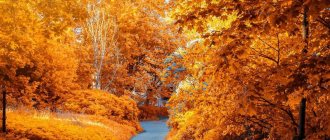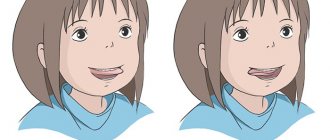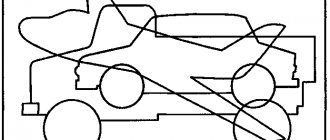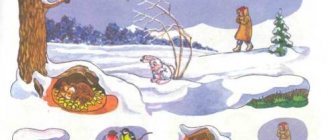Lesson notes for the senior group. Animal world
Summary of the lesson “Animal World” for children of the senior group
Author: Slobodskaya Angela Olegovna. Objectives: 1. Expand knowledge about domestic and wild animals. 2. Distinguish between different animals according to their characteristic features, continue to familiarize children with the classification of animals (wild, domestic). 3. Name baby animals. 4. Develop emotional responsiveness, aesthetic perception of the surrounding world, and form an ecological culture. 5. Foster a caring attitude towards living nature. Develop aesthetic perception. Preliminary work: looking at illustrations, books, drawing and sculpting animals, reading books, memorizing poems, guessing riddles.
Progress of the lesson:
There is a recording of the voices of domestic animals (cows, horses, pigs, goats) - which animals’ voices do you recognize?
(children's answers). - What are these animals called in one word? (children's answers). The teacher asks you to remember what other pets there are? (children's answers). Why are they called pets? (children's answers). What benefits do they bring? (children's answers). There is a recording of the voices of wild animals (bear, wolf, hare) - what animal voices do you recognize? (children's answers). - What are these animals called in one word? (children's answers). Why are they called wild? (children's answers). — Tell me, what are the characteristics of animals? (they have paws, a tail, a muzzle, fur) The teacher suggests a musical break. Song "Zverobika". The cat sat down on the window and began to wash her ears with her paw. After watching her a little, we can repeat her movement. Chorus: One, two, three, come on, repeat, Three, four, five - repeat again. One, two, three, come on, repeat, Three, four, five, repeat again. Very good. A snake crawls along a forest path, like a ribbon slides along the ground. And we can depict this movement for you with our hands. Chorus:
stands all day in the swamp And catches frogs with its beak.
It’s not at all difficult to stand like that for us, for trained guys. Chorus:
The monkey came down from the branch to us, The monkey must be respected.
After all, monkeys are our ancestors, and children, we must imitate our ancestors. Chorus:
There are a lot of monkeys, cats and animals in the world, But, man, you are a friend of nature And you must know the habits of all animals.
Chorus
- And now I’ll tell you riddles, if the answer is correct, then a card with a picture of this animal will be posted.
Riddles: 1. Shaggy, mustachioed, drinks milk, sings songs. (cat) 2. She doesn’t speak, doesn’t sing, but who goes to the owner, She lets him know. (dog) 3. In front there is a snout, in the back there is a hook, in the middle there is a back, on the back there is a bristle. (pig) 4. Neither the lamb nor the cat Wears a fur coat all year round. The fur coat is gray for summer, for winter - a different color. (hare) 5. Like a Christmas tree, covered in needles. (hedgehog) 6. Fluffy tail, golden fur lives in the forest, steals chickens in the village. (fox) 7. Who wanders around in the cold winter, angry and hungry. (wolf) 8. The owner of the forest, wakes up in the spring, And in winter, to the howl of a blizzard, Sleeps in a snowy hut. (bear) 9. He’s waiting for me on the road. He beats his hoof at the gate. His mane plays in the wind. Lush, fabulously beautiful. I’ll quickly jump onto the saddle and fly clop-clop-clop. (horse) 10. She is big, with horns and hooves on her legs. The tail is like a panicle. It eats hay and gives milk. (cow) - Guys, let's count how many pets there are? Count it. (Children count at the blackboard). Game "Name the Cubs" . (One-many) Game “Who lives where? " (Figures of domestic and wild animals are laid out on the table. 2 children are called. One child will put the wild animals in the forest, and the other child - in the hut). The teacher uses a “magic” wand to transform children into forest dwellers. “And now you and I will close our eyes and turn into forest dwellers.” Physical education One-squat, two-jump This is a rabbit exercise, And when the foxes wake up, they like to stretch for a long time. Be sure to yawn and wag your tail. And the wolf cub arches its back, And jumps lightly, The cub bear, with his paws spread wide, First one, then both together, Marks time for a long time. And for those who don’t have enough exercise, it starts all over again. - Fine! And now I again turn you into our obedient children (close our eyes). Working at a desk. Give the children sheets of paper and pens. — Guys, let’s listen to the task: “Animals (wild and domestic) are drawn here.” Wild animals need to be circled, and domestic animals need to be led to the barn (hut) with an arrow.” The children do the work. The teacher walks among the children and watches how they complete the task. (Calm music sounds). Educator : Thank you guys, it’s very interesting and fun to be with you. Now, tell me, what would happen if all the animals on earth disappeared? Summarizing the children's answers, the teacher talks about the need for all animals in nature. Educator: And now our children will read B. Zakhoder’s poem “Everyone in the World is Needed.” Summary of the lesson: “What animals did we talk about? (Children's answers). Today you all tried very hard and answered well. Well done! Let's say "Thank you" to each other!
We recommend watching:
Summary of educational activities in the senior group “Journey to a Fairy Tale” Summary of a mathematics lesson for children of the senior orthopedic group Summary of educational and gaming activities in the senior group in the section of the “Childhood” program Thematic day in kindergarten “Animal Day”
Similar articles:
Lesson in the senior group of kindergarten on the topic of February 23
Lesson notes for children of senior preschool age. Topic: Invisible air
Summary of organized educational activities for children of the senior group
Notes for mathematics classes in the senior group
Lesson summary on the topic “Reserve” in the senior group





